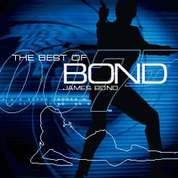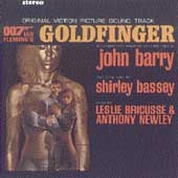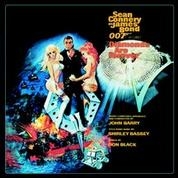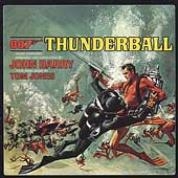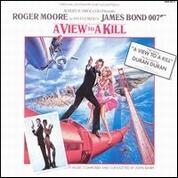|
You are reading the older HTML site Positive Feedback ISSUE 10october/november 2003
James Bond Mania
No other movie spy has ever equaled the success of Ian Fleming’s super-cool, super-suave, super secret agent, Bond… James Bond. Bond movie #20, Die Another Day, was recently released, and there is no end in sight—Pierce Brosnan is rumored to have signed on for at least two, possibly three more films! Always set in the most beautiful surroundings, with crazy plots involving villains taking over the world (or destroying it), James Bond movies have managed to capture everyone’s attention, young and old, male and female. The James Bond franchise has raked in some four billion dollars in worldwide ticket sales, and this fails to account for the VHS/DVD dollars and other merchandising revenue. Of course, the fast cars, the beautiful women, and the grand sets and settings need to be supported with a score, and especially an opening title song, performed in the past by such stars as Shirley Bassey, Tina Turner, and Louis Armstrong, and, in the latest movie, Madonna. Since nothing was ever good enough for (most) Bond movies, the series’ producers, Albert Broccoli and Harry Saltzman, turned to legendary Hollywood film composer and conductor John Barry for the films’ musical settings and orchestral support. Ironically, the James Bond theme, the most famous of all JB titles—essentially the title track to the very first Bond movie, Dr. No—caused a legal commotion until the case was settled in 2001. Monty Norman was widely credited as being the composer of the track, but John Barry claimed to have co-written it. Norman sued Barry, and the judge ruled in favor of Norman. Despite this, John Barry is THE quintessential Bond composer, having written eleven of the series’ twenty scores. As Bond movies became more in tune with the modern era around the mid 80s, the scores started losing much of their old-world charm, as full-blown orchestras were increasingly replaced with synthesizers and electronic music. It is no surprise that most Bond aficionados view the scores written after A View To A Kill —the ones without John Barry at the helm—as undeserving of the Bond legacy. I tend to agree. As a long-time Bond nut, I am proud to say that I own most of the Bond titles on vinyl, though it took me the better part of four months to get there. (I have only recently begun collecting LPs.) Local record swap meets yielded some excellent selections, but for the most part, eBay proved to be the way to go. At any given time, you can find a decent number of James Bond titles. Much to my surprise, most are in good condition, and if you are lucky, you can even find some of the more recent titles brand spankin’ new. I suppose that if you are really, really lucky, you can locate sealed material dating back to the 70s. In chronological order, I have thus far secured the following titles: Dr. No (1962), From Russia With Love (1963), Goldfinger (1964), Thunderball (1966), You Only Live Twice (1967), On Her Majesties Secret Service (1969—truly the most oddball of Bond movies), Diamonds are Forever (1971), Live And Let Die (1973), The Man With The Golden Gun (1974—a commercial flop), The Spy Who Loved Me (1977), Moonraker (1979—among the most commercially successful Bond movies of all time and one of my personal favorites), For Your Eyes Only (1981—the first Bond movie not scored by John Barry, and another of my favorites), Octopussy (1983), and last but not least, A View To A Kill (1985—Roger Moore’s final Bond movie, and the end of the "classic" era of Bond movies). For the fortieth anniversary of the franchise, Capitol went through a major restoration process (though, truth be told, we don’t know exactly how extensive) to offer all of the Bond titles in full glory on CD, remastered from the original tapes. Even though I was tempted to pick up all the titles, I restricted myself to only one CD, the fortieth anniversary greatest hits edition. I am sure that the Capitol remasters are as good as the market warrants, yet I felt compelled to get this collection in vinyl format, for originality’s sake if nothing else, and of course for richer sonic performance. How do they sound? I am happy to report that, in general, the recording quality ranges from good to decent, though it varies to a greater degree on some of the newer material. Naturally, since we are talking about used vinyl, it all depends in part on the previous owners’ care. In my case, most records were handled carefully, though some show signs of being played over and over on mediocre record players. Scratches, pops, ticks, and such are a given, though a good vinyl washer should result in better performance. Musically, on the other hand, every record is a testament to the production quality of the Bond movies. You are never in doubt that you are listening to a Bond soundtrack—even people who are not familiar with the movies almost always identify them as such. This is where John Barry gets the credit, and rightfully so. His brilliance lies in his ability to carefully match each scene precisely with the corresponding melody and tune. Having seen all of the Bond movies many times over, I cannot imagine any other composer doing such an outstanding job. Listening to each record, I can clearly visualize every scene, and I cannot say the same about many other movies. Until perhaps Moonraker, Barry’s choice of a full-blown orchestra to capture the visceral impact of the various scenes was a wise choice. Later movies substituted such lavish arrangements in favor of electronic instruments, and it shows. I’d like to say a few words about my favorites among the soundtracks.
Goldfinger, the third movie in the series, is held by many to be the quintessential Bond movie. Some critics have gone so far as to say that this movie established the franchise, as well as Sean Connery, a relatively unknown actor at the time. Whether or not this is true, it certainly is one of the best Bond movies. Shirley Bassey had the honor of singing the title tune, and her amazingly powerful voice set the pattern for the future Bond movie title tracks, which to this day are cued up some ten to fifteen minutes after the opening scene, with the now-classic credit scrolls set in fantastic, sometimes unbelievable worlds. The Goldfinger soundtrack emphasizes the mid and upper ranges. Bass is there, but is certainly not spectacular. If you want to test your system, play the opening theme song—if you have to stop it after the first 60 seconds or so, you know you have a problem. The movie deals with a certain maniac’s desire to wreak havoc in the world’s financial markets by neutralizing Fort Knox’s gold supply (this was before Nixon took us off the gold standard in 1971), and the score has a certain sense of glitz, gold, and glamour. Credit again goes to Berry for integrating the movie’s plot into the score. Each scene is rendered carefully, with climaxes carefully interacting with luxurious string sequences. My E.A.R./Transrotor/Shelter turntable setup masterfully extracted every spatial cue to portray a grand soundstage befitting the best of Bond movies. The quiet background allowed the full-blown dynamics to come through in all their glory.
Diamonds Are Forever, another Sean Connery classic, again teams up the treacherous trio—Shirley, John, and Sean. Here we are clearly moving into a more modern era of Bond, as after all, it’s the 70s. Everything seems faster paced, though that could have simply been part of the fact that the movie almost exclusively takes place in the U.S. of A. The tracks correspond nicely to the scenes. The title track is more pop-oriented and glittery, which surely has to do with the fact that quite a bit of movie time is spent in Las Vegas. Unfortunately, the sound quality is on the shrill side. Yes, the orchestra is there, but no, this is not Swan Lake. Soundstage width, depth, and height are all believable, yet I can’t help but wonder the exact location of the recording. It does not sound like Albert Hall. Most of the tracks do have a Las Vegas feel to them—glitzy, glamorous, superficial. Connery’s suave manner carried those scenes with great style. Diamonds Are Forever is one of my favorite Bond movies, one I can watch time and time again. The critics weren’t as impressed with it as I am, but who are they to tell me what is good and what isn’t?
Thunderball takes place in the groovy 60s, and it shows. It has that typical old-time spy movie feel to it, with a plot set at the height of the cold war. The evil Largo has stolen a couple of nukes and is threatening to unleash them if his demands are not met. He keeps the nukes on his ship, the Disco Volante. The great Tom Jones performs the title track, with lyrics by Don Black. His husky voice adds a certain element of suave to the title track, while John Berry’s score and orchestral arrangement works the rest of the magic. Sound quality is not bad, though nothing special, and soundstaging is only so-so. There is no magic layering, but the music is another thing. It’s enjoyable! Bond music was never designed to be used for speaker evaluation. What it does well—extraordinarily well in some instances—is offer a solid foundation for the pictures’ intricate plots, themes, etc. The music takes you places you have never been, or will ever likely visit. Who cares about that last bit of resolution, or the fact that the recording is on the thin and bright side? I don’t. I get immense pleasure listening to these records.
A View To A Kill brings me flashbacks like perhaps only two or three of the other Bond movies. I was only 15 when it came out, and my older brother had to sneak me in, through a buddy of his who worked at the theater. Watching the coolest Bond flick since Octopussy was a treat, and the jealousy and envy of my friends followed me for months to come. I was totally impressed with movie and its star, Roger Moore. Topping it off, my favorite band at the time, Duran Duran, performed the title track, which I played over and over, much to my mother’s discontent. This Full Digital Recording (this was released at a time when CDs were becoming popular, and the recording industry had to find ways to lure people into buying vinyl) sounds bombastic. Barry clearly was changing with the times, as distorted and grunged-out guitars often accompany the orchestra. The recording is fairly good, though. You do get a sense of a massive soundstage coupled with pinpoint imaging and life-size acoustic energy, provided you have a system capable of reproducing it. The big bass drums hitting off in the upper left portion of the soundstage are very convincing. Horns are everywhere. One particular passage, Wine With Stacy, is soaked in suaveness. Again it becomes clear that Barry is a master of his craft. I believe that A View To A Kill is the last of the classic Bond movies. The Bond character fundamentally changed in the mid-80s. Political correctness ended up in the films, and the suave, super-secretive character was assassinated. Most importantly, the entire geo-political system had changed—gone was the evil Russian empire, and along came ultra-smooth villains and terrorists. Honorable mention in this series should go to On Her Majesties Secret Service, starring George Lazenby, the only actor ever to have played James Bond only once. (Even the movie’s villain, Telly Savalas, managed to rack up quite an extensive movie career!) The movie was nothing special—a world-wrenching villain vs. JB. Musically, though, we have a true gem, with Louis Armstrong doing the honors with his rendition of We Have All The Time In The World. Even Nancy Sinatra appears on this soundtrack—You Only Live Twice is her track, and a catchy one at that. The sound is pretty decent, with nice soundstaging and a deep, wide presentation. It is focused, yet dynamic, and nicely layered, indeed. Strings, a plethora of bass drums, and, well, the typical John Barry score in full force. Each and every one of these magnificent albums represents a must-have in my vinyl collection. Do yourself and your ears a favor, go out and buy these records! You will have a good time… I promise.
|

